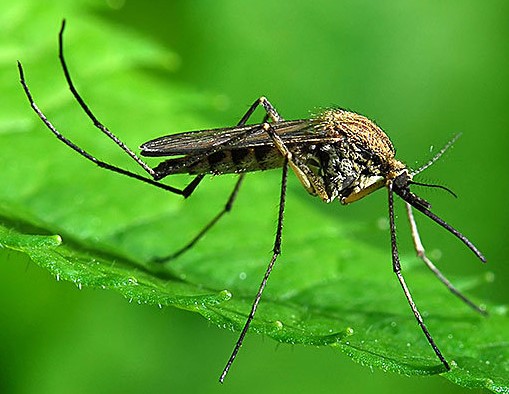Veterinarians remind about the need to treat cows against parasites before grazing

Experts emphasize that the housefly is a carrier of over 50 types of microorganisms, most of which are pathogens of dangerous diseases. But the greatest danger is that theseFlies can carry helminth larvae, veterinary experts note.
The autumn stinger fly also poses a danger to cattle . it can be a carrier of anaplasmosis, brucellosis and even anthrax.
Midges attack cows in large numbers in open spaces. Their bites are not only extremely painful for animals, but also dangerous. They can provoke simuliotoxicosis - a toxic-allergic disease accompanied by itching, swelling and the formation of papules. Animals may develop hyperemia and tachycardia.
Mosquitoes carry arbovirus infections, filariasis, anaplasmosis. Horseflies carry anaplasmosis, tularemia and anthrax. By the way, theseInsects prefer dark-colored cows. "Black and black-and-white, as well as dirty animals, are especially hard hit," the State Veterinary Committee noted.
The gadfly is another dangerous insect for cattle, which causes hypodermatosis. Females lay eggs on the skin of cows . The larvae that hatch from them penetrate the skin, and through the bloodstream and tissues reach the esophagus and cavities of the spinal canal. There they spend the winter, develop, and in the spring they bite through the skin and continue their development in the external environment. Through the passages they make, an infection often enters the cow's body .
Another parasite that is dangerous for cows in the pasture is the ixodid tick. It can carry pathogens of blood parasitic diseases, including babesiosis and piroplasmosis. The peak activity of these parasites occurs in July, since this month is the most favorable weather for them.
Read together with it:
- Цены на говядину в Ростовской области резко увеличилисьЦены на яйца, в свою очередь, колеблются в зависимости от затрат на корма, ветеринарные препараты, энергоресурсы и упаковку, однако в этом году они снизились на 18,35%. На фоне этого также наблюдается падение цен на некоторые фрукты и овощи, входящие в «борщевой набор»: капуста подешевела на 26,48%, картофель на 14,......
- Meat production has increased in the Angara region, but milk yields are declining.However, despite the increase in MEAT production, MILK yield declined by 1.6%, and egg production fell by 2.9%. Agricultural organizations accounted for the bulk of production, accounting for 99.4% of poultry, approximately 90% of pork and eggs, and approximately a quarter of all milk. At the same time, animal productivity increased: the average milk yield per cow was 5,68......
- Цены на яйца и мясо в Крыму увеличились из-за роста затрат производителейПо данным Крымского информационного агентства, в сентябре цены в регионе выросли на 0,8% по сравнению с августом. Услуги стали дешевле, но ограничения в предложении определённых продуктов также способствовали удорожанию. Несмотря на общую тенденцию, средняя стоимость яиц в Крыму остается ниже, чем по стране, с годовым снижением более чем на 15%.......
- Personal responsibility, modernization. What measures is the Ministry of Agriculture and Food taking to reduce mortality?October 27, MINSK . To reduce cattle mortality, the Ministry of Agriculture and Food is focusing on disease prevention, infrastructure modernization, and increased accountability at all levels of government. Ivan Smilgin, Deputy Minister of Agriculture and Food and DIRECTOR of the Department of Veterinary and Food Surveillance, spoke to a BELTA correspondent about which measures are producing tang...
- Цены на мясные продукты в России продолжают расти: анализ причин и прогнозыАналитики связывают это с перераспределением спроса, поскольку покупатели стали больше покупать курятину из-за удорожания других видов мяса. Производство птицы увеличилось, однако ожидаемое восстановление цен после весеннего падения пока еще не произошло. Тем временем, несмотря на общий рост цен на мясо, яйца сохраняют стабильные расценки. Прогнозы на будущее остаются неопределенными и зависят от ...
- Производство яиц растёт в Липецкой областиЗа девять месяцев 2025 года в хозяйствах всех категорий региона получено 702,4 млн яиц. Это на 8 % больше, чем за аналогичный период прошлого года. Основным производителем и поставщиком пищевого куриного яйца в Липецкой области является сельхозпредприятие, две площадки которого расположены в Липецком округе и Грязинском районе. В день там получают порядка 1,6 млн штук яиц. За три квартала текущего...
- Increasing egg production of laying hens in Kabardino-Balkaria: successes and prospectsThe increase in chicken population has been a key factor in this growth. Currently, the total number of laying hens in the republic has reached 2.3 million, a 14% increase over last year. This demonstrates that local farmers are actively expanding their farms by implementing modern technologies and poultry care methods. The main reasons for increased egg production include: Improved feeding: Farme...
- Indonesia: New rules to protect farm animalsKey Provisions of the New Regulation The new draft law , currently being reviewed, sets ambitious goals. it will cover all categories of animals—from farm animals to pets, service animals, and laboratory animals. The primary focus is on implementing a certification system for farmers who are committed to more humane and sustainable farming practices. This will not only improve animal welfare but a...


